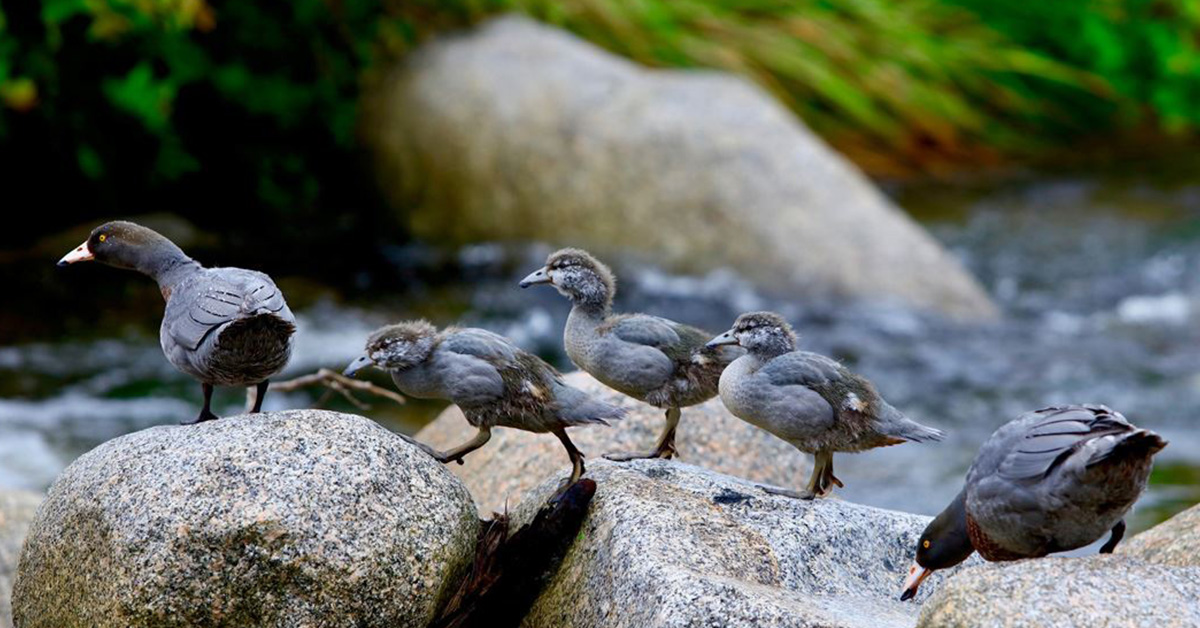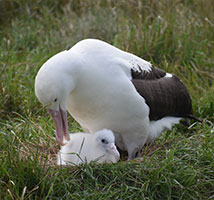
Four Corners
Away with the Birds
Birds are arguably this country’s most iconic and loved inhabitants, so for spring, aka baby season, we’ve collected the best places to spy the next generation of charmers (technically, their hatching times do vary). For the clearest — and least intrusive view — pack binoculars.
TIRITIRI MATANGI
Lighting the Way
Many little black fluff balls have grown into big blue takahe on this island sanctuary. The first came inside an egg given to two clucky males to nurture in the early 1990s. Usually though, a female lays two eggs two days apart between October and January, and the babies hatch 30 days afterwards. Chicks stay with their parents right up to the next breeding season or into their second year. They can often be spotted near the island’s lighthouse.
TANGIHUA RANGES
Big Baby
In November, riroriro (grey warblers) can be spotted placing fresh insects into the beaks of much larger, iridescent birds. It is the bigger bird who is the baby, albeit of a different species. Pīpīwharauroa (shining cuckoos) are brood parasites: they lay eggs into other species nests, usually grey warblers, who then rear their young. The chicks depend on their foster parents for food for several weeks.
OPOUTERE BEACH
Fluffy Runners
Tūturiwhatu (northern New Zealand dotterel) love east coast beaches. A scrape in the sand, sometimes decorated with driftwood, holds three speckled eggs laid between August and September. A month or so later long-legged, big-headed chicks emerge, their plumage halo-like. Chicks freeze or hide when threatened, while parents distract intruders by running around or feigning injuries.

Tūturiwhatu (northern New Zealand dotterel).
Photo: Manu Davison
TONGARIRO NATIONAL PARK
Our $10 Darling
Whio (blue duck) live in pairs, dotted on fiercely guarded 1–5 km sections of rivers. Their riverside nests are built in caves, holes, fern clumps or under fallen trees. In September, five or six ducklings peck their way out of pale eggs. Parents closely guard them for about two months, so until December families can be seen battling the currents or munching on bugs together.

Whio (blue duck). Photo: Richard Rossiter, DOC
PUREORA FOREST PARK
Not Even a Bird
“Bird of the year” for 2021, pekapeka-touroa (long-tailed bat) have big ears and tiny, dark eyes. Expectant mothers gather and birth pups in December, and by January’s warm evenings, the babies take their first flights. Watch around forest margins for a distinctive flight with quick turns as they hunt insects. Charmingly, they’ll cut a silhouette much like the batman symbol — but in miniature.
TAIAROA HEAD
Royal Down
Between February and June, you’d be forgiven for thinking you were looking at little lambs on the slopes of Taiaroa Head. Toroa (northern royal albatross) chicks are covered in white, fluffy down for their first 100 or so days. From July, they flap and hold out their wings, building strength for their journey ahead. Come October, they will take flight, and spend three to five years at sea.

Toroa (northern royal albatross).
Photo: Laura Findlay
FIORDLAND NATIONAL PARK
Bobbing Delights
Pīwauwau (rock wren) live in tracts of rocks up to 2500m above sea level. Small and modest mountaineers, they can be identified their constant bobbing, curtseying, ducking and hopping among rocks. Chicks are hidden away inside fully enclosed nests made partly from hundreds of feathers from other birds. This makes them hard to see, but if you’re trying to spot a tiny bird they should still fit the bill given they weigh less than an AA battery.

Pīwauwau (rock wren).
Photo: CC By 2.0 Andrew/Flickr
Tulia Thompson is a The Next Page intern, a role funded by NZ On Air’s Public Interest Journalism.

This story appeared in the December 2022 issue of North & South.


